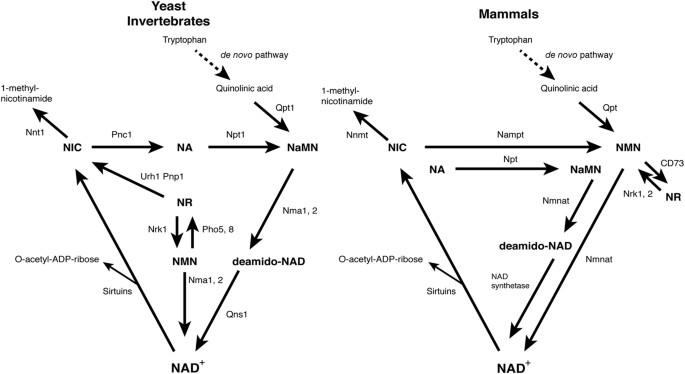It takes two to tango: NAD+ and sirtuins in aging/longevity control
IF 4.1
Q2 GERIATRICS & GERONTOLOGY
引用次数: 277
Abstract
The coupling of nicotinamide adenine dinucleotide (NAD+) breakdown and protein deacylation is a unique feature of the family of proteins called ‘sirtuins.’ This intimate connection between NAD+ and sirtuins has an ancient origin and provides a mechanistic foundation that translates the regulation of energy metabolism into aging and longevity control in diverse organisms. Although the field of sirtuin research went through intensive controversies, an increasing number of recent studies have put those controversies to rest and fully established the significance of sirtuins as an evolutionarily conserved aging/longevity regulator. The tight connection between NAD+ and sirtuins is regulated at several different levels, adding further complexity to their coordination in metabolic and aging/longevity control. Interestingly, it has been demonstrated that NAD+ availability decreases over age, reducing sirtuin activities and affecting the communication between the nucleus and mitochondria at a cellular level and also between the hypothalamus and adipose tissue at a systemic level. These dynamic cellular and systemic processes likely contribute to the development of age-associated functional decline and the pathogenesis of diseases of aging. To mitigate these age-associated problems, supplementation of key NAD+ intermediates is currently drawing significant attention. In this review article, we will summarize these important aspects of the intimate connection between NAD+ and sirtuins in aging/longevity control.

探戈需要两个人控制衰老/长寿的 NAD+ 和 sirtuins
烟酰胺腺嘌呤二核苷酸(NAD+)分解与蛋白质脱乙酰化的耦合是被称为 "sirtuins "的蛋白质家族的一个独特特征。NAD+ 与 sirtuins 之间的这种密切联系源远流长,它提供了一个机理基础,将能量代谢的调节转化为对各种生物体衰老和长寿的控制。尽管sirtuin研究领域经历了激烈的争议,但最近越来越多的研究已经平息了这些争议,并完全确立了sirtuin作为进化保守的衰老/长寿调节因子的意义。NAD+ 和 sirtuins 之间的紧密联系受多个不同水平的调控,这进一步增加了它们在代谢和衰老/长寿调控中协调作用的复杂性。有趣的是,有研究表明,随着年龄的增长,NAD+的可用性会下降,从而降低sirtuin的活性,在细胞水平上影响细胞核与线粒体之间的交流,在系统水平上影响下丘脑与脂肪组织之间的交流。这些动态的细胞和系统过程可能会导致与年龄相关的功能衰退和衰老疾病的发病机制。为了缓解这些与年龄相关的问题,补充关键的 NAD+ 中间体目前正引起人们的极大关注。在这篇综述文章中,我们将总结 NAD+ 和 sirtuins 在衰老/长寿控制中密切联系的这些重要方面。
本文章由计算机程序翻译,如有差异,请以英文原文为准。
求助全文
约1分钟内获得全文
求助全文

 求助内容:
求助内容: 应助结果提醒方式:
应助结果提醒方式:


